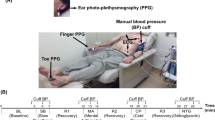Abstract
We present experimental evidence suggesting, contrary to previous models, that arm cuff induced pulse arrival time (PAT) changes are primarily created under the cuff, and that they increase with cuff length and decrease with arterial diameter. The observed PAT changes are consistent with a transmission line model for the cuff segment of the arm.
Preview
Unable to display preview. Download preview PDF.
Similar content being viewed by others
References
1. Westhoff, T. H., Straub-Hohenbleicher, H., Schmidt, S., Tölle, M., Zidek, W., & van der Giet, M. (2005). Convenience of ambulatory blood pressure monitoring: comparison of different devices. Blood pressure monitoring, 10(5), 239-242.
2. Penaz, J., Voigt, A., & Teichmann, W. (1976). Contribution to the continuous indirect blood pressure measurement. Zeitschrift fur die gesamte innere Medizin und ihre Grenzgebiete, 31(24), 1030-1033.
3. Ilies C, Bauer M, Berg P, Rosenberg J, Hedderich J, Bein B, Hinz J, Hanss R (2012) Investigation of the agreement of a continuous non-invasive arterial pressure device in comparison with invasive radial artery measurement. Br J Anaesth 108(2):202-10.
4. Wagner JY, Negulescu I, Schöfthaler M, Hapfelmeier A, Meidert AS, Huber W, Schmid RM, Saugel B (2015) Continuous nonin-vasive arterial pressure measurement using the volume clamp method: an evaluation of the CNAP device in intensive care unit patients. J Clin Monit Comp 29(6):807-13.
5. A. Steptoe, H. Smuylan, and B. Gribbin, “Pulse Wave Velocity and Blood Pressure Change: Calibration and Applications”, Psychophysiology, Vol.13, No.5, pp. 488-493, 1976.
6. Bresch, E., Schmitt, L., De Matteis, D., & Muehlsteff, J. (2016, August). Cuff-pressure induced PAT changes—modelling and experimental verification towards calibration of blood pressure surrogates. In Engineering in Medicine and Biology Society (EMBC), 2016 IEEE 38th Annual International Conference of the (pp. 4252-4255). IEEE.
7. Yan, Y. S., and Y. T. Zhang. “A model-based calibration method for noninvasive and cuffless measurement of arterial blood pressure.” Biomedical Circuits and Systems Conference, 2006. BioCAS 2006. IEEE. IEEE, 2006.
8. Yan, Y. S., and Y. T. Zhang. “A novel calibration method for noninvasive blood pressure measurement using pulse transit time.” Medical Devices and Biosensors, 2007. ISSS-MDBS 2007. 4th IEEE/EMBS International Summer School and Symposium on. IEEE, 2007.
9. McCOMBIE, Devin, and Guanqun Zhang. “System for calibrating a blood pressure measurement based on vascular transit of a pulse wave.” U.S. Patent Application No. 14/833,078.
10. Solà, J., Vetter, R., Renevey, P., Chételat, O., Sartori, C., & Rimoldi, S. F. (2009). Parametric estimation of pulse arrival time: a robust approach to pulse wave velocity. Physiological measurement, 30(7), 603.
11. John, L. R. (2004). Forward electrical transmission line model of the human arterial system. Medical and Biological Engineering and Computing, 42(3), 312-321.
12. Drzewiecki, G., Hood, R., & Apple, H. (1994). Theory of the oscillometric maximum and the systolic and diastolic detection ratios. Annals of biomedical engineering, 22(1), 88-96.
13. Bramwell, J. Crighton, and Archibald Vivian Hill. “The velocity of the pulse wave in man.” Proceedings of the Royal Society of London. Series B, Containing Papers of a Biological Character 93.652 (1922): 298-306.
14. Avolio, A. P. (1980). Multi-branched model of the human arterial system. Medical and Biological Engineering and Computing, 18(6), 709-718.
Author information
Authors and Affiliations
Corresponding author
Editor information
Editors and Affiliations
Rights and permissions
Copyright information
© 2018 Springer Nature Singapore Pte Ltd.
About this paper
Cite this paper
Bresch, E., Muehlsteff, J., Schmitt, L. (2018). Cuff-induced changes of pulse arrival time: models and experimental results. In: Eskola, H., Väisänen, O., Viik, J., Hyttinen, J. (eds) EMBEC & NBC 2017. EMBEC NBC 2017 2017. IFMBE Proceedings, vol 65. Springer, Singapore. https://doi.org/10.1007/978-981-10-5122-7_26
Download citation
DOI: https://doi.org/10.1007/978-981-10-5122-7_26
Published:
Publisher Name: Springer, Singapore
Print ISBN: 978-981-10-5121-0
Online ISBN: 978-981-10-5122-7
eBook Packages: EngineeringEngineering (R0)




